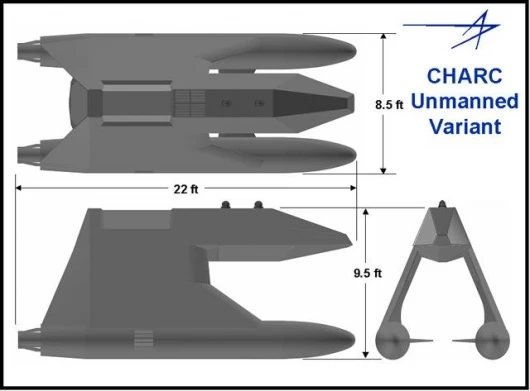March 6, 2005 The CHARC is designed to provide a lethal response for some of the emerging littoral threats facing large Navy vessels including suicide speedboats packed with explosives, small high-speed boat "swarm attacks" and diesel-electric submarines. With similar offensive capabilities to that of an AH-1W Super Cobra helicopter crammed onto a high-speed surface platform, the CHARC is small, fast and stealthy and can attack on a moment's notice using an array of Hellfire missiles, 20-millimeter guns, 40-millimeter grenade launchers and torpedoes. Like the AH-1W Super Cobra, a crew of two control the craft from a forward cockpit.
Lockheed Martin's proposed CHARC is a Small Waterplane Area Twin Hull (SWATH) design that offers extreme stability, even in high sea states.
Like its namesake (the CHARC is pronounced "shark"), it has plenty of bite, being armed to the teeth.
Indeed, it has many strengths and helicopter-like characteristics in its design and weapons assortment but differs from a helicopter in three important ways:
1 - it floats, thus enabling it to remain in an area for a long time,
2 - it has a very low signature so it's difficult to detect, track or shoot with most weapons
3 - it travels at extremely high speed on, rather than above the water.
Accordingly, it is able to loiter, patrol and attack in shallow littoral waters and it has the ability to sit low in the water for long periods and then "pop-up and dash" to suspected threats when speed is needed with a top speed of 60 knots.
An interesting amalgamation of many Lockheed Martin advanced technologies, the CHARC operates from a larger mother ship such as an amphibious support ship or possibly the new Littoral Combat Ship and responds quickly to changing threats as it supports an assortment of weapon and/or sensor mission modules that can be changed out in a few hours. It also provides limited mine-hunting capability for the detection and destruction of mines it encounters in shallow water.
Very Low Signature
As the CHARC is semi-submersible, and the emmissions from its twin 3,000-horse power diesel engines are exhausted into the water, this eliminates or significantly reduces infrared emission signatures in the littoral environment.
The CHARC is also designed to have a low radar signature and accordingly, it can lie low or patrol covertly for hours at a time, but with the ability to attack on a moments notice with a lethal capability that begins with the nose-mounted slewable 20mm rapid-fire gun and gets nastier from there.
On each side of the fuselage are four internal weapons bays that can be configured appropriately for dealing with the most likely threats. For example, one might hold a canisterised AGM-114 Hellfire missile or Joint Common Missile for line-of-sight engagements, or perhaps Lockheed Martin's NetFires system could be incorporated for a beyond-line-of-sight attack capability or even a 40mm grenade launcher.
Reconfigurable
CHARC is a geometrically reconfigurable SWATH craft. Standing tall, it can withstand high sea states with the main body of the craft cruising between two and five metres above the water s. Its design avoids rather than mitigates the shock of going fast in a small ship in high sea states.
Reconfigured for shallow waters, the CHARC has an astonishing minimum draft of just 1.5m, enabling it to patrol up estuaries and contribute significantly to situational awareness.
As the CHARC uses directional waterjets for its propulsion, it is also very manoeuvrable.
Yet it is also foldable so it can be taken aboard mother ships and can operate in very shallow waters. So when the threat has been neutralised, the 12 metre CHARC folds up into a space not much larger than a SEAL team inflatable boat and when compressed it has steerable wheels to facilitate fast and easy storage.
Accordingly, several CHARCs can be carried on each ship, offering a formidable school of CHARCs to ward of would-be attackers.
Insertion of SEAL teams
The CHARC has a rear-access hatch to allow a SEAL team to enter and exit the craft easily, and one of its primary anticipated roles is seen as inserting special operation forces into hot spots. There are two configurations for the CHARC, one that can carry six SEALS and one that carries eight.
Controlling unmanned auxiliary craft
Another potential use for the CHARC is as a forward control and monitoring station for unmanned air, surface and underwater craft - with the capacity to respond immediately and lethally should the unmanned craft detect a threat.
Sensitive eyes and ears
The CHARC will have a retractable sensor mast and further sensors in its nose - no details are yet available of the suite of sensors, but they can be expected to include a number of the systems used in other Lockheed Martin machinery, and almost certainly infra-red sensing.
The CHARC development team at Lockheed martin is currently looking for higher levels of program funding.








